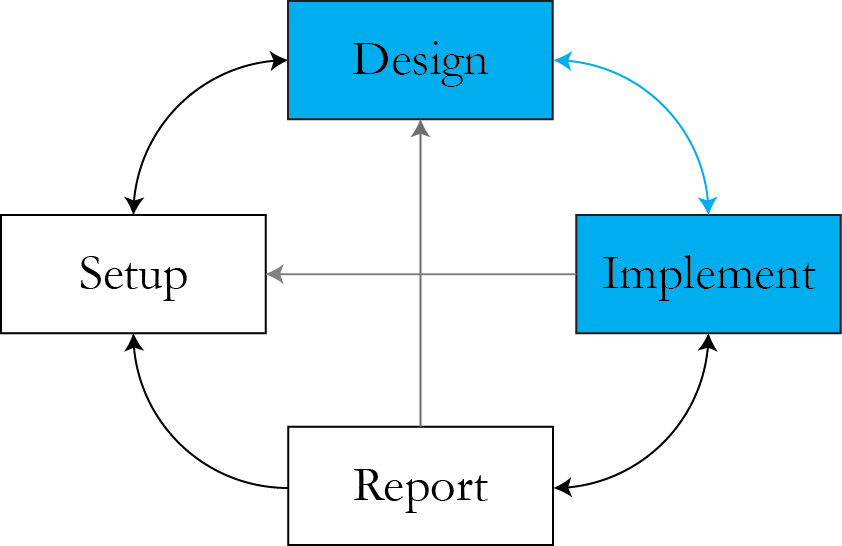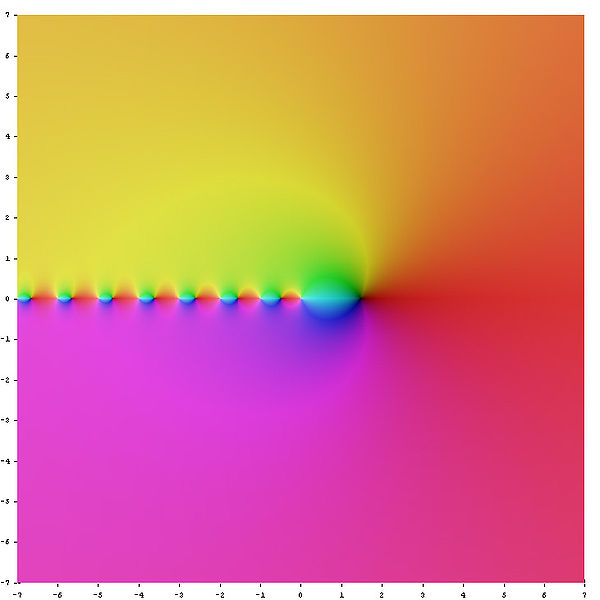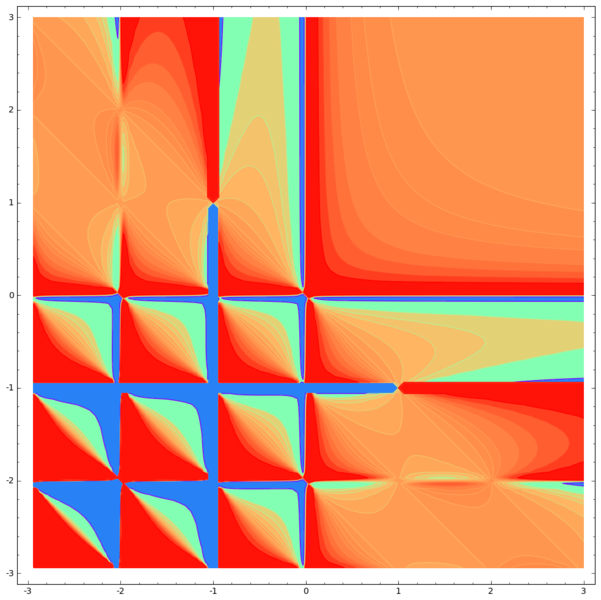Expectation-Maximization Algorithm
Stat 221, Lecture 10
Missing Data
Related questions and tradeoffs:
- Is the missing data mechanism (MDM) ignorable?
- What is the sensitivity of inference to MDM specification?
- Is the MDM specification justified?
- MCAR/MAR/NMAR distinction.
Latent variables
Related questions and tradeoffs:
- By design, are the latent variables identifiable from parameters?
- Is the intuition there?
Both LV and MD
- Does the inference algorithm fully explore the domain, find all modes?
- Justification for the selected inference algorithm.
- Need more practice (Psets 3-5).
Inference with LV/MD

EM algorithm
- Example: ignorant and health aware intentions and running.
For a single person:
$$Z \sim \rr{Beta}(\alpha,\beta), \rr{ } Y_i \given Z \sim \rr{Bernoulli}(Z)$$
Example: likelihood
$$\begin{align}L(\{ \alpha, & \beta\}\given Y, Z) \\ &\propto \prod_{i=1}^n\frac{1}{\rr{B}(\alpha,\beta)}\, z^{y_i + \alpha-1}(1-z)^{1 - y_i + \beta-1}\end{align}$$
The algorithm
- Initialize a starting value \\( \theta = \theta^{0}\\).
- E step: find \\( Q \\) - the expected value of complete-data log-likelihood given observed data and current values of parameters. $$Q\left( \theta | \theta^{(t)} \right) = \int l(\theta | y) f( Y_{\rr{mis}}| Y_{\rr{obs}}, \theta = \theta^{(t)}) dY_{\rr{mis}}$$
- M step: maximize \\( Q \\) with respect to parameters. $$Q \left(\theta^{(t+1)} \given \theta^{(t)}\right) \geq Q\left(\theta \given \theta^{(t)}\right)$$
- Iterate between 2 and 3.
Back to example
Main trick is getting the distribution of missing data given observed data and parameters.
$$Z |Y, \alpha, \beta \sim \rr{Beta}\left(\alpha + \sum Y_i, \beta + \sum \left( 1 - Y_i \right) \right)$$
$$E \left( Z \given Y, \alpha, \beta\right) = \frac{\alpha + \sum Y_i}{\alpha + \beta + n}$$
But
The \\( Q \\) function is $$\begin{align}Q = E_{z} & \sum_{i = 1}^n \left[ -\rr{log} \rr{B}(\alpha, \beta) + (y_i + \alpha -1) \rr{log} z \right. \\ & \left. + (1 - y_i + \alpha -1) \rr{log} (1 - z) \right]\end{align}$$
Specifically
$$ \begin{align}Q = & \sum_{i = 1}^n \left[ -\rr{log} \rr{B}(\alpha, \beta) + (y_i + \alpha -1) E_{z}\left(\rr{log} z\right) \right. \\ & \left. + (1 - y_i + \alpha -1) E_z\left(\rr{log} (1 - z)\right) \right]\end{align}$$
Luckily
- We know the expected value of the log of a Beta: $$ E_z (\rr{log} Z) = \psi\left(\alpha + \sum Y_i\right) - \psi (\alpha + \beta + n)$$
- \\( \psi \\) is the digamma function

Beta: another pretty function

Algorithm
- Set initial values for \\( \alpha, \beta \\).
- Calculate \\(E_{z}\left(\rr{log} z\right) \\) and \\( E_z\left(\rr{log} (1 - z)\right) \\) given current values of \\( \alpha, \beta \\) and observed data.
- Set new values \\( \{ \alpha, \beta\} = \rr{argmax}_{\alpha, \beta} \left[ Q(\alpha, \beta) \right]\\) using the calculated values of \\(E_{z}\left(\rr{log} z\right) \\) and \\( E_z\left(\rr{log} (1 - z)\right) \\).
- Iterate between 2 and 3 till convergence.
Deriving EM
- Relies on Jensen's inequality, and that $$\begin{align}f(Y\given \theta) & = f(Y_{\rr{obs}}, Y_{\rr{mis}} \given \theta) \\ & = f(Y_{\rr{obs}} \given \theta) f(Y_\rr{mis} \given Y_\rr{obs}, \theta)\end{align}$$
- Or, by non-negative property of Kullback-Leibler divergence (proved by Jensen's inequality).
- Reference: Little and Rubin pp. 172-174.
Some specifics
Complete-data density
$$\begin{align}f(Y\given \theta) & = f(Y_{\rr{obs}}, Y_{\rr{mis}} \given \theta) \\ & = f(Y_{\rr{obs}} \given \theta) f(Y_\rr{mis} \given Y_\rr{obs}, \theta)\end{align}$$
Complete-data log-likelihood
$$\begin{align}l(\theta \given Y) = l(\theta \given Y_{\rr{obs}}) + \rr{log} f(Y_\rr{mis} \given Y_\rr{obs}, \theta)\end{align}$$
Rewrite
$$\begin{align}l(\theta \given Y_{\rr{obs}}) = l(\theta \given Y) - \rr{log} f(Y_\rr{mis} \given Y_\rr{obs}, \theta)\end{align}$$
Take expectation
With respect to \\( Y_\rr{mis} \\) and current estimate \\( \theta^{(t)} \\):
$$\begin{align}l(\theta \given Y_{\rr{obs}}) = Q(\theta \given \theta^{(t)}) - H(\theta \given \theta^{(t)})\end{align}$$
$$\begin{align}Q(\theta | \theta^{(t)}) = \int \left[ l(\theta | Y_{\rr{obs}}, Y_{\rr{mis}})\right]f(Y_{\rr{mis}}| Y_{\rr{obs}}, & \theta^{(t)}) \\ &dY_{\rr{mis}}\end{align}$$
$$\begin{align} H(\theta | \theta^{(t)})= \int & \left[ \rr{log} f(Y_{\rr{mis}}| Y_{\rr{obs}}, \theta^{(t)}) \right] \\ & f(Y_{\rr{mis}}| Y_{\rr{obs}}, \theta^{(t)})dY_{\rr{mis}}\end{align}$$
By Jensen's
$$H \left(\theta \given \theta^{(t)}\right) \leq H \left( \theta^{(t)} \given \theta^{(t)} \right)$$
Also can use the non-negative property of KL divergence (same thing).
Finally
$$\begin{align} l( \theta^{(t+1)} | & Y_{\rr{obs}}) - l( \theta^{(t)} | Y_{\rr{obs}}) = \\ & [Q( \theta^{(t+1)} | Y_{\rr{obs}}) - Q( \theta^{(t)} | Y_{\rr{obs}})] \\ & - [H( \theta^{(t+1)} | Y_{\rr{obs}}) - H( \theta^{(t)} | Y_{\rr{obs}})]\end{align}$$
Since at each iteration of EM we maximize \\( Q \\), the observed-data likelihood must increase.
Fraction of missing info.
- Reference: Little and Rubin pp. 177-179.
$$I(\theta \given Y_\rr{obs}) = -D^{20} Q(\theta \given \theta) + D^{20} H( \theta \given \theta)$$
For converged \\( \theta = \theta^* \\), define
$$\begin{align}i_\rr{com} &= \left.-D^{20} Q(\theta \given \theta)\right|_{\theta=\theta^*} \\ i_\rr{obs} & = \left.I(\theta \given Y_\rr{obs})\right|_{\theta=\theta^*} \\ i_\rr{mis} & = \left. -D^{20} H( \theta \given \theta)\right|_{\theta=\theta^*} \end{align}$$
Then have
$$i_\rr{obs} = i_\rr{com} - i_\rr{mis}$$
$$DM = i_\rr{mis}i_\rr{com}^{-1} = I - i_\rr{obs}i_\rr{com}^{-1}$$
\\( DM \\) is the fraction of missing information matrix.
Speed of convergence of EM
Generally, for \\( \theta^{(t)} \\) near \\( \theta^* \\):
$$| \theta^{(t+ 1)} - \theta^* | = \lambda | \theta^{(t)} - \theta^*|$$
where \\( \lambda = DM \\) for scalar \\( \theta \\) and the largest eigenvalue of \\( DM \\) for vector \\( \theta \\).
- Dempster, Laird and Rubin (1977)
Ways to "integrate out" missing data
Integrating out the missing data is better, but not always possible. Solutions:
- MCMC+
- EM+
- mcEM
- vEM
Essential for computing
- Writing the \\( Q \\) function in R vectorization-friendly form.
- Implementing vectorized functions.
Example
$$ \begin{align}Q = & \sum_{i = 1}^n \left[ -\rr{log} B(\alpha, \beta) + (y_i + \alpha -1) E_{z}\left(log z\right) \right. \\ & \left. + (1 - y_i + \alpha -1) E_z\left(log (1 - z)\right) \right] = \\ = & n \left[-\rr{log} B(\alpha, \beta) + \left( \bar{y} + \alpha - 1\right)E_{z}\left(log z\right) \right. \\ & \left.+ (1 - \bar{y} + \alpha - 1)E_z\left(log (1 - z)\right) \right]\end{align}$$
Precalculate \\( \bar{ y} \\).
Announcements
- T-shirt competitions reminder: it's fun and useful!
Resources
- Slides nesterko.com/lectures/stat221-2012/lecture10
- Class website theory.info/harvardstat221
- Class Piazza piazza.com/class#spring2013/stat221
- Class Twitter twitter.com/harvardstat221
Final slide
- Next lecture: More on EM, EM for HMM
Case study: research
Alex Franks, non-ignorable missing data mechanism in systems biology.
